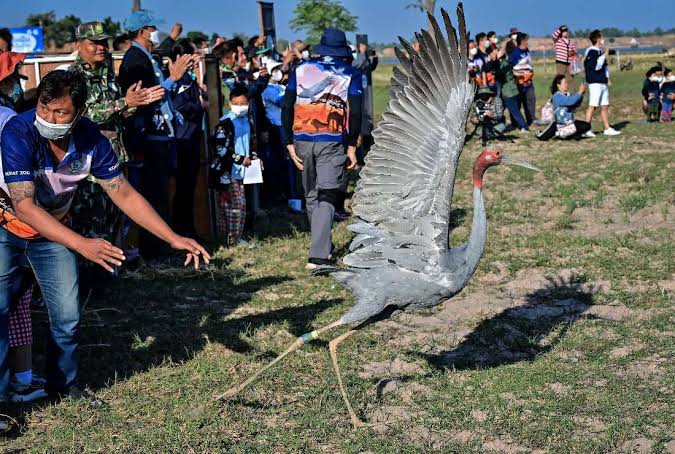Rare Sarus cranes released in northeast Thailand

a pair of Sarus cranes that were captively-bred at Nakhon Ratchasima Zoo after being released at Huai Chorakhe Mak reservoir in the eastern Thai province of Buriram.
As the sun came up, 13 Sarus cranes were released over a rippling reservoir in northeast Thailand, the latest effort to revive the almost-extinct species in the kingdom.
More commonly known as Thai cranes, the birds nearly disappeared from the country roughly 50 years ago – they were last spotted in the wild in 1968 – before a collaboration between the Thai government, Nakhon Ratchasima Zoo and United Nations to save them.
A breeding program, using fowl donated by Cambodia, began in 1989, with the first reintroduction in 2011.
Sarus cranes are classed by the ICNC as “vulnerable,” with an estimated 15,000 remaining in the wild – with the Thai sub-species having been thought to have disappeared from Thailand’s wild wetlands.
But since 2011, more than 150 captively-bred birds – which can grow to up to six feet (1.8 meters) and weigh almost seven kilograms – have been released in Buriram Province.
“It is the only place where the Thai cranes are able to live and reproduce on their own,” said Governor Chaiwat Chuntirapong.
The birds were transported in large, specially adapted boxes – their red-feathered heads watching through mesh windows – from the Wetland and Eastern Sarus Crane Conservation Center where they were bred to the Huai Chorakhe Mak Reservoir.
The latest flock of 13 cranes were released all at once on Christmas Day. The tall birds loudly honked and clumsily flapped as they unsteadily took to the skies accompanied by cheering children and spectators.
It was the final moment in a long journey for the researchers, who carefully nurtured the cranes from hatching, gradually introduced them to the wild and then took them to their final flight to freedom.
As a result of the long process, roughly 60 to 70 percent of the birds survive in the wild, he said.
Prior to their release, each bird is micro-chipped and tagged, allowing researchers to track them and improve the conservation efforts.



